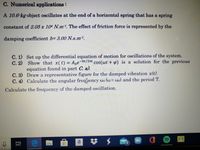Question
thumb_up100%

Transcribed Image Text:C. Numerical applications:
A 10.6-kg object oscillates at the end of a horizontal spring that has a spring
constant of 2.05 x 104 N.ml. The effect of friction force is represented by the
damping coefficient b= 3.00 N.s.ml.
C. 1) Set up the differential equation of motion for oscillations of the system.
C. 2) Show that x(t) = Ane-bt/2m
equation found in part C. a).
C. 3) Draw a representative figure for the damped vibration x(t).
C. 4) Calculate the angular freqiency oo ( 00) and the period T.
cos(@t + o) is a solution for the previous
Calculate the frequency of the damped oscillation.
梦 $
(3)
a.
Expert Solution
This question has been solved!
Explore an expertly crafted, step-by-step solution for a thorough understanding of key concepts.
This is a popular solution
Trending nowThis is a popular solution!
Step by stepSolved in 4 steps with 5 images

Knowledge Booster
Similar questions
- A spring with spring constant 18.0 N/m hangs from the ceiling. A 510 g ball is attached to the spring and allowed to come to rest. It is then pulled down 7.80 cm and released. Part A What is the time constant if the ball's amplitude has decreased to 2.60 cm after 53.0 oscillations? Express your answer with the appropriate units. HA Value Unitsarrow_forwardI would like some help with thus problem, thank you!arrow_forward1: In this question we will study the damped harmonic oscillator. Consider the following spring-mass system. kr bà Figure 1: Spring-mass system with a friction force. That is, an object of mass m is attached at the end of a spring with spring-constant k. We will also consider the effect of friction. Friction works in the opposite direction of motion, as illustrated in the figure. A) Show that the differential equation governing the damped spring-mass system is: më = -bå – kx (1) dr and i = dt where i = dt2 b) To solve the differential equation (1), we will take the following ansatz: r(t) = Ae. (2) If the above r(t) is a solution of Eq. (1) show that A has to satisfy the following equation: 1² +27d + wi = 0, (3) * and wi = k Solve the above equation to find A. m2 b where y 3= 2m c) For wi >?, show that the general solution can be written as: x(a) = Ae-t cos (wt +0) (4) where w? = w - 7². 2: Using Fermat's principle prove the law of reflection and the law of refraction of light.arrow_forward
- A mass of 1.64 Kg is connected to a spring of spring constant 9.02 N/m. An oscillation is started by pulling the mass to the right to amplitude 0.779 m before release and the oscillator moves in air. The oscillation decays to 16.7% of the original amplitude in 63.5 seconds. a. What would the position of the oscillation be 29.63 seconds after release?arrow_forwardA 75 kg mass is attached to an ideal massless spring with a spring constant of 15 N/m oscillates on a horizontal, frictionless track. A time t=0.00 s, the mass is released from rest at x=10 cm. a- Find the frequency of the oscillations. b-determin the maximum speed of the mass. At what point in the motion does the maximum speed occur? c-What is the maximum acceleration of the mass? At what point does the maximum acceleration occur? d-Determin the total energy of the oscillating system. e-Express the displacement x as a function of timearrow_forwardq5arrow_forward
arrow_back_ios
arrow_forward_ios